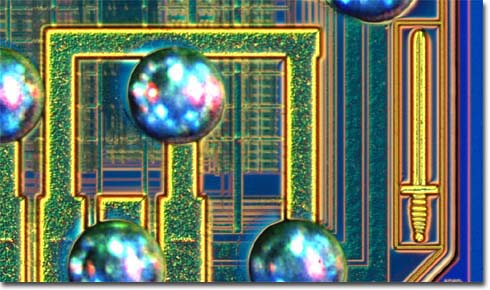Big Mac Attack (Excalibur)
|
We spotted this medieval 300-micron long sword near the scribe line on a Motorola/IBM PowerPC 750, the microprocessor that is behind the wave of new "Pentium Killer" Macintosh G3 computers. At first we thought the sword represented the fact that the chip is on the cutting edge of RISC processor technology, but we now believe it to be a concealed weapon to keep the processor competitive in the life-threatening chip wars. Another reason for the presence of the sword icon may be that the G3 chips were code-named "Arthur" as in Camelot, and the sword represents Excalibur. In a massive international advertising campaign, Apple boasted this processor to be up to twice as fast as a comparable Intel microprocessor, meaning that a routine task requiring 30 seconds by the G3 Mac would take at least a minute on a Pentium II 400. Regardless of whether these sensational claims are true, the PowerPC 750 microprocessor has most certainly breathed new life into a once-struggling, but very popular platform. The PowerPC 750, built in a joint collaboration between IBM and Motorola, is a superscalar processor featuring six independent execution units and 32 Kbyte eight-way instructional and data caches. Transistor gate size is 0.17 microns, an indicator of the advanced manufacturing process used in the fabrication of this microprocessor. Over 6.4 million transistors are crammed onto a die that is approximately a third the size of Intel's Pentium II and III and consumes only about a fourth of the power (5 watts for the PowerPC as opposed to 20 for the Pentiums). |
© 1995-2025 by Michael W. Davidson and The Florida State University. All Rights Reserved. No images, graphics, software, scripts, or applets may be reproduced or used in any manner without permission from the copyright holders. Use of this website means you agree to all of the Legal Terms and Conditions set forth by the owners.
This website is maintained by our
|
